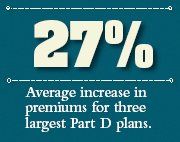Part D plans boost fees for 2008
Change was in the wind as the Medicare Part D open enrollment period began last month. Most seniors who belong to stand-alone prescription drug plans (PDPs) face premium increases.

At the same time, many smaller plans are reducing premiums and rolling out more low-cost options. A report from the Kaiser Family Foundation shows that only 19% of PDP enrollees face premium hikes of more than $10 a month, and that half the increases are less than $10. Across the country, PDP premiums range from less than $10 to more than $100 per month.
Many insurers offered fairly low premiums in 2006 to attract enrollees to the new program and now are adjusting rates to fit the market. High drug utilization, rising drug prices and changes in how Medicare reimburses plans are all driving plans to hike premiums, boost copays and narrow coverage for beneficiaries in the donut hole, according to industry executives.
WIDER GAP
In addition to raising premiums, most PDPs are narrowing donut-hole coverage. There is no gap coverage for brand-name drugs by any stand-alone PDP in 2008, and only one Medicare Advantage plan (MA-PD) is offering that benefit. Nearly one-third of PDPs do cover some generic drugs, but increasingly limited to "select" or "preferred" products and at a high cost: The Kaiser data indicates that premiums for plans with gap coverage are twice as high as no-gap plans ($63 vs. $30 on average). Consequently, only about a 8% of seniors participating in Part D have signed up for plans offering that benefit. MA-PDs are able to offer more attractive donut hole coverage of generic drugs, an option that attracted one-third of MA-PD enrollees last year.
SHIFTING DUALS
Higher PDP premiums have made some large plans ineligible to serve low-income dual eligibles. The Centers for Medicare and Medicaid Services (CMS) estimated in October that about 1.6 million of about 7 million dual-eligibles enrolled in PDPs will be switched automatically to new plans that offer premiums below the $25 benchmark. For example, Humana estimates that about 300,000 low-income members will be reassigned by Medicare to lower-cost plans. UnitedHealth similarly may lose about 650,000 duals from its PDPs.
Some plan sponsors are not actively seeking dual eligibles. Full government subsidies for low-income beneficiaries may make them less likely to control drug spending through use of mail-order or generic drugs, according to some observers. The situation is prompting policy analysts to look for alternative methods for CMS to calculate benchmarks to avoid switching duals every year.
CMS and health advocates are advising seniors to take a close look at their current coverage and alternative options. While some PDPs may have raised premiums, total beneficiary costs will be determined by a mix of copays, deductibles and formulary coverage. CMS continues to look for ways to limit Part D choices to plans offering substantial differences.
Extending the Capabilities of the EHR Through Automation
August 2nd 2023Welcome back to another episode of "Tuning In to the C-Suite," where Briana Contreras, an editor of Managed Healthcare Executive, had the pleasure of chatting with Cindy Gaines, chief clinical transformation officer at Lumeon.
Listen
Automate Your Practice's Workflows with These 5 Tools
October 4th 2023To maintain patient satisfaction and regulatory compliance and reduce potential clerical errors while maintaining high productivity, you can ease your staff’s burdens by automating your practice’s workflows and empower your staff to do more in less time.
Read More